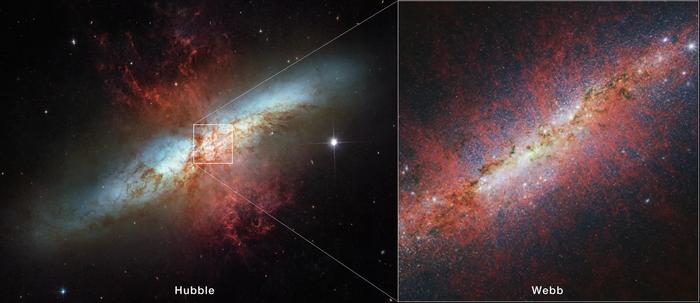A team of astronomers has used NASA’s James Webb Space Telescope to survey the starburst galaxy Messier 82 (M82). Located 12 million light-years away in the constellation Ursa Major, this galaxy is relatively compact in size but hosts a frenzy of star formation activity. For comparison, M82 is sprouting new stars 10 times faster than the Milky Way galaxy.

Credit: NASA, ESA, CSA, STScI, A. Bolatto (University of Maryland)
A team of astronomers has used NASA’s James Webb Space Telescope to survey the starburst galaxy Messier 82 (M82). Located 12 million light-years away in the constellation Ursa Major, this galaxy is relatively compact in size but hosts a frenzy of star formation activity. For comparison, M82 is sprouting new stars 10 times faster than the Milky Way galaxy.
Led by Alberto Bolatto at the University of Maryland, College Park, the team directed Webb’s NIRCam (Near-Infrared Camera) instrument toward the starburst galaxy’s center, attaining a closer look at the physical conditions that foster the formation of new stars.
“M82 has garnered a variety of observations over the years because it can be considered as the prototypical starburst galaxy,” said Bolatto, lead author of the study. “Both NASA’s Spitzer and Hubble space telescopes have observed this target. With Webb’s size and resolution, we can look at this star-forming galaxy and see all of this beautiful, new detail.”
A Vibrant Community of Stars
Star formation continues to maintain a sense of mystery because it is shrouded by curtains of dust and gas, creating an obstacle in observing this process. Fortunately, Webb’s ability to peer in the infrared is an asset in navigating these murky conditions. Additionally, these NIRCam images of the very center of the starburst were obtained using an instrument mode that prevented the very bright source from overwhelming the detector.
While dark brown tendrils of heavy dust are threaded throughout M82’s glowing white core even in this infrared view, Webb’s NIRCam has revealed a level of detail that has historically been obscured. Looking closer toward the center, small specks depicted in green denote concentrated areas of iron, most of which are supernova remnants. Small patches that appear red signify regions where molecular hydrogen is being lit up by a nearby young star’s radiation.
“This image shows the power of Webb,” said Rebecca Levy, second author of the study at the University of Arizona, Tucson. “Every single white dot in this image is either a star or a star cluster. We can start to distinguish all of these tiny point sources, which enables us to acquire an accurate count of all the star clusters in this galaxy.”
Finding Structure in Lively Conditions
Looking at M82 in slightly longer infrared wavelengths, clumpy tendrils represented in red can be seen extending above and below the galaxy’s plane. These gaseous streamers are a galactic wind rushing out from the core of the starburst.
One area of focus for this research team was understanding how this galactic wind, which is caused by the rapid rate of star formation and subsequent supernovae, is being launched and influencing its surrounding environment. By resolving a central section of M82, scientists could examine where the wind originates, and gain insight on how hot and cold components interact within the wind.
Webb’s NIRCam instrument was well-suited to trace the structure of the galactic wind via emission from sooty chemical molecules known as polycyclic aromatic hydrocarbons (PAHs). PAHs can be considered as very small dust grains that survive in cooler temperatures but are destroyed in hot conditions.
Much to the team’s surprise, Webb’s view of the PAH emission highlights the galactic wind’s fine structure – an aspect previously unknown. Depicted as red filaments, the emission extends away from the central region where the heart of star formation is located. Another unanticipated find was the similar structure between the PAH emission and that of hot, ionized gas.
“It was unexpected to see the PAH emission resemble ionized gas,” said Bolatto. “PAHs are not supposed to live very long when exposed to such a strong radiation field, so perhaps they are being replenished all the time. It challenges our theories and shows us that further investigation is required.”
Lighting a Path Forward
Webb’s observations of M82 in near-infrared light spur further questions about star formation, some of which the team hopes to answer with additional data gathered with Webb, including that of another starburst galaxy. Two other papers from this team characterizing the stellar clusters and correlations among wind components of M82 are almost finalized.
In the near future, the team will have spectroscopic observations of M82 from Webb ready for their analysis, as well as complementary large-scale images of the galaxy and wind. Spectral data will help astronomers determine accurate ages for the star clusters and provide a sense of timing for how long each phase of star formation lasts in a starburst galaxy environment. On a broader scale, inspecting the activity in galaxies like M82 can deepen astronomers’ understanding of the early universe.
“Webb’s observation of M82, a target closer to us, is a reminder that the telescope excels at studying galaxies at all distances,” said Bolatto. “In addition to looking at young, high-redshift galaxies, we can look at targets closer to home to gather insight into the processes that are happening here – events that also occurred in the early universe.”
These findings have been accepted for publication in The Astrophysical Journal.The James Webb Space Telescope is the world’s premier space science observatory. Webb is solving mysteries in our solar system, looking beyond to distant worlds around other stars, and probing the mysterious structures and origins of our universe and our place in it. Webb is an international program led by NASA with its partners, ESA (European Space Agency) and the Canadian Space Agency.
Journal
The Astrophysical Journal
Article Title
JWST Observations of Starbursts: Polycyclic Aromatic Hydrocarbon Emission at the Base of the M 82 Galactic Wind



